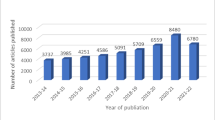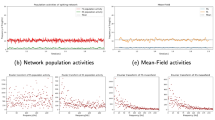Summary
-
1.
The EEG, recorded monopolarly from the pial surface, was investigated during insuline induced hypoglycemia in acute cats and compared with the activity of cortical cells recorded with intra or “quasi-intracellular” electrodes.
-
2.
Pathological changes of the EEG were observed only when the blood glucose fell below 25–30 mg-%. Electrical silence was observed at blood glucose levels below 15–10 mg-%.
-
3.
The essentially flat, “desynchronized” EEG of the awake animal before hypoglycemia did not show any relation between the small, irregular fast EEG- potentials and the statistically distributed cellular potentials. —During the regular 8–10/sec spindles (Fig. 3) a close correlation was found between the single surface- negative spindle waves and the mostly subthreshold compound cellular EPSP's.
-
4.
Slow waves of δ-frequency showed similar but less close correlations, if the waves were of regular appearance comparable to “monomorphic” δ-waves (Fig.4A). Other forms of slow complex potentials (Fig.4B and C), which correspond to “polymorphic” δ-waves in an EEG-record (e.g. Fig.4C and Fig.2d) may show different relations between cellular and EEG-activity which were, however, consistent for each type of complex wave.
-
5.
Sharp waves were divided into primary positive and primary negative bi- (or tri-)phasic potentials. The primary positive phase was always shorter (below 20–40 msec) than the primary negative phase (above 100 msec). The mostly suprathreshold cellular depolarization, which may lead to a short burst of discharge, coincided with the primary, i.e. either the primary positive or the primary negative phase (Fig. 7 shows records from the same cell and different EEG-phenomena). The phase coupling, i.e. the “synchronization” with the EEG-potential, is closer in the primary positive than the primary negative waves, and the duration of the cellular depolarization is also shorter in the former case (compare Fig.7B I–III with 7B IV). This can be interpreted as stronger synchronization of cellular activity during the short primary positive waves.
-
6.
A causal relation between cortical neuronal activity and EEG-potentials is assumed. Differences in the closeness of phase coupling and the changing phase relation between cellular and EEG-activity according to the form and steepness of cortical EEG-potentials are explained by a simple model of electrogenesis of EEG-potentials, which takes in account the degree of synchronization of corticopetal and cortico-fugal fibre activity as well as the summation of postsynaptic potentials of cortical neurones.
Zusammenfassung
-
1.
An Katzen wurden EEG-Veränderungen durch Hypoglykämie hervorgerufen und mit den Aktivitätsveränderungen corticaler Neurone verglichen, wie sie sich bei intracellulären und „quasi-intracellulären“ Ableitungen darstellen. Es zeigte sich, daß pathologische EEG-Veränderungen erst bei niedrigen Blutzuckerwerten (zwischen 30 und 25 mg-%) auftreten und daß es erst bei Werten unter 10–15 mg-% zur elektrischen Stille kommt.
-
2.
Während des flachen, desynchronisierten EEG des wachen Hirns vor Hypoglykämie lassen sich keine Beziehungen zwischen den kleinen EEG- und statistisch verteilten Zellpotentialen nachweisen. — Während der regelmäßigen 8–10/sec- Spindelgruppen, die bei tiefer Hypoglykämie häufig zu beobachten sind, findet sich eine enge Korrelation zwischen den einzelnen Oberflächen-negativen Spindelwellen und Zelldepolarisationen, die meist unterschwellig sind.
-
3.
Bei den langsamen Wellen der δ-Frequenz finden sich ähnliche, aber weniger enge Korrelationen für die flachen, „monomorphen“ δ-Wellen. Andere Formen von langsamen Potentialkomplexen des Cortiocogramms, die im Tintenschreiber als „polymorphe“ δ-Wellen imponieren können, zeigen etwas andere, aber für den einzelnen Wellenkomplex jeweils konstante Beziehungen zur Zellaktivität.
-
4.
Die steilen Wellen wurden unterteilt in primär positive und in primär negative bi- (oder auch tri-)phasische Potentiale. Die primäre Phase der primär-positiven steilen Potentiale ist im Durchschnitt kürzer (unter 20–40 msec) als die negative Phase der primär-negativen Phase (über 100 msec). Die meist überschwellige Zelldepolarisation, die in der Regel zu einer kurzen Gruppenentladung führt, fällt mit der primären Phase, also entweder der positiven oder der negativen zusammen. Die Phasenkoppelung, d. h. die „Synchronisation“ mit dem EEG-Potential, ist jedoch im Fall der primär-positiven Phase enger und die Dauer der Depolarisation kürzer als im Fall der primär-negativen steilen Potentiale. Diese Befunde werden als Hinweis auf eine stärkere Synchronisation der Aktivität der corticalen Nervenzellpopulation im Fall der primär-positiven steilen Potentiale gewertet.
-
5.
Die verschieden engen Phasenkoppelungen und die je nach Steilheit der Wellen wechselnden Phasenbeziehungen zwischen Zellaktivierung und oberflächennegativen resp. -positiven Potentialen werden an Hand eines einfachen Modells der Elektrogenese von EEG-Potentialen erklärt, das den Synchronisationsgrad cortico-petaler und cortico-fugaler Faseraktivität sowie die Summation postsynaptischer Potentiale corticaler Neurone berücksichtigt.
Similar content being viewed by others
Literatur
Adey, R.: Persönliche Mitteilung (1967).
Andersen, P., S. A. Andersson, and T. Lømo: Nature of Thalamo-corticalrelations during spontaneous barbiturate spindle activity. J. Physiol. (Lond.) 192, 283 to 307 (1967).
, and T. Sears: The role of inhibition in the phasing of spontaneous thalamocortical discharge. J. Physiol. (Lond.) 173, 459–480 (1964).
Calvet, J., M. V. Calvet et J. Scherrer: Étude stratigraphique corticale de l'activité EEG spontanée. Electroenceph.clin.Neurophysiol. 17, 109–125 (1964).
Caspers, H.: Die Entstehungsmechanismen des EEG. 7. Tagg. der Dtsch. EEG-Gesellschaft, Bad Nauheim 1958.
Creutzfeldt, O.: Activité neuronique du système nerveux central: de quelques aspects de l'activité neuronique unitaire corticale et de ses rapports avec l'électroencéphalogramme. In H. Fischgold et al. (Eds.): Problèmes de base en électroencéphalographie, pp. 34–60. Paris: Masson 1963.
-, and U. Kuhnt: The visual evoked potential: Physiological, developmental and clinical aspects. Electroenceph. clin. Neurophysiol. Suppl., 1–13 (1967).
-, and J. J. Meisch: Changes of cortical neuronal activity and EEG during hypoglycemia. Electroenceph. clin. Neurophysiol. Suppl. 24, 158–171 (1963).
, S. Watanabe, and H. D. Lux: Relations between EEG phenomena and potentials of single cortical cells. I. Evoked responses after thalamic and epicortical stimulation. Electroenceph. clin. Neurophysiol. 20, 1–18 (1966).
: Relations between EEG phenomena and potentials of single cortical cells. II. Spontaneous and convulsoid activity. Electroenceph. clin. Neurophysiol. 20, 19–37 (1966).
Elul, R.: Statistical mechanisms in generation of EEG. Progr. Biomedic. Engin. 1, 131–150 (1967).
Klee, M. R., and K. Offenloch: Postsynaptic potentials and spike patterns during augmenting responses in cat's motor cortex. Science 143, 488–489 (1964).
Knauff, H. G.: Die tiefe Hypoglykämie und ihre Folgen für das Zentralnervensystem. Münch. med. Wschr. 108, 2483–2490 (1966).
Massion, J., P. Angaut et D. Albe-Fessard: Activités évoquées chez le chat dans la région du nucleus ventralis lateralis par diverses stimulations sensorielles. II. Etude micro-physiologique. Electroenceph. clin. Neurophysiol. 19, 452–469 (1965).
McIlwain, J. T., and O. D. Creutzfeldt: Microelectrode study of synaptic excitation and inhibition in the lateral geniculate nucleus of the cat. J. Neurophysiol. 30, 1–21 (1967).
Petsche, H., u. A. Marko: Über die Ausbreitung der Makrorhythmen am Gehirn des Menschen und des Kaninchens auf Grund toposkopischer Untersuchungen. Arch. Psychiat. Nervenkr. 193, 177–198 (1955).
Spencer, W. A., and J. M. Brookhart: A study of spontaneous spindle waves in sensorimotor cortex of cat. J. Neurophysiol. 24, 50–65 (1961).
Stefanis, C., and H. Jasper: Recurrent collateral inhibition in pyramidal tract neurons. J. Neurophysiol. 27, 855–877 (1964).
Tews, J. K., S. H. Carter, and W. E. Stone: Chemical changes in the brain during insulin hypoglycaemia and recovery. J. Neurochem. 12, 679–693 (1965).
Ziegler: Normal EEG at deep levels of hypoglycaemia. Electroenceph. clin. Neurophysiol. 9, 523 (1957).
Author information
Authors and Affiliations
Rights and permissions
About this article
Cite this article
Mergenhagen, D., Creutzfeldt, O. & Neuweiler, G. Beziehungen zwischen Aktivität corticaler Neurone und EEG-Wellen im motorischen Cortex der Katze bei Hypoglykämie. Archiv für Psychiatrie und Zeitschrift f. d. ges. Neurologie 211, 43–62 (1968). https://doi.org/10.1007/BF00341671
Received:
Published:
Issue Date:
DOI: https://doi.org/10.1007/BF00341671




